James Dean was the quintessential Hollywood bad-boy of the 1950s. But who was the young man behind the legacy–and what style lessons can we learn from him?
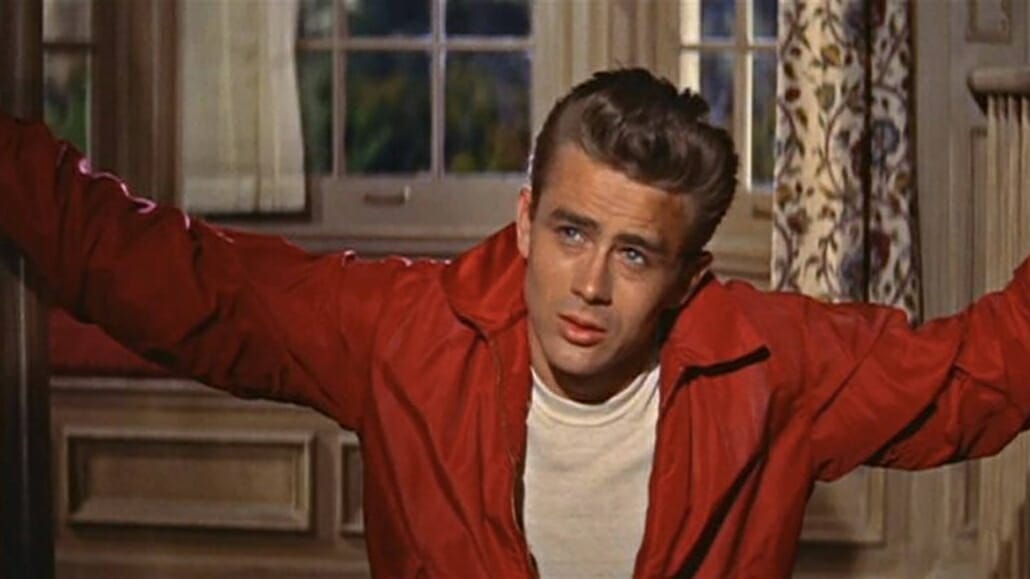
Gentleman of Style: James Dean
Best remembered for his star-making turn as disaffected outcast Jim Stark in the 1955 film, Rebel Without a Cause, and for his whirlwind life that was cut short at just 24 years of age, the casual cool of James Dean still looms large over the popular consciousness. With this in mind, there are several style lessons to be learned from this bad-boy of the silver screen–and despite being outside the typical mold for an entry in this series, we believe he can still unquestionably be considered a Gentleman of Style.
Early Life – From Indiana Farm Boy to Aspiring Actor
James Byron Dean was born on February 8, 1931, in Marion, Indiana, the only child of Winton Dean, a farmer, and Mildred Marie Wilson. Six years after his father had left farming to become a dental technician, Dean moved with his family to Santa Monica, California.
The family spent several years there, and by all accounts, Dean was very close to his mother; he was devastated when she died of uterine cancer when Dean was nine years old. Unable to care for his son, Dean’s father sent him to live with his aunt and uncle back in Fairmount, Indiana.
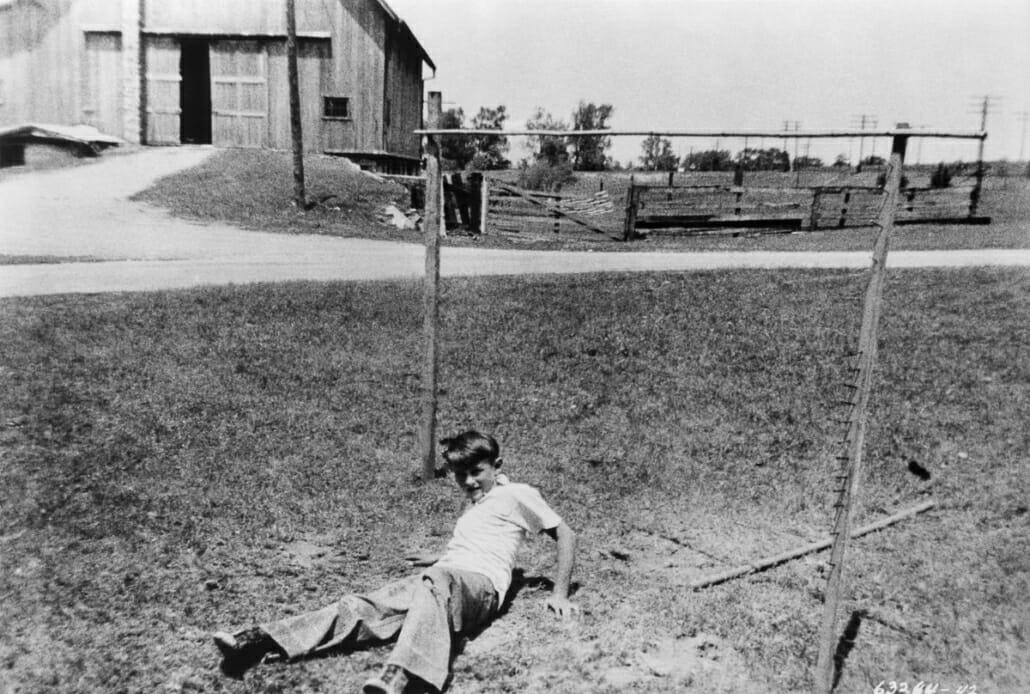
In school, Dean was a good student and socially well-liked, playing baseball and varsity basketball, studying drama, and competing in public speaking. After graduating from Fairmount High School in 1949, he moved back to California to live with his father and stepmother.
He enrolled in Santa Monica College, majoring in pre-law, but then transferred to UCLA and changed his major to drama, which resulted in estrangement from his father. While at UCLA, Dean was picked from a group of 350 actors to portray Malcolm in Macbeth and participated in acting workshops on campus. In January 1951, he dropped out of UCLA to pursue a full-time career as an actor.
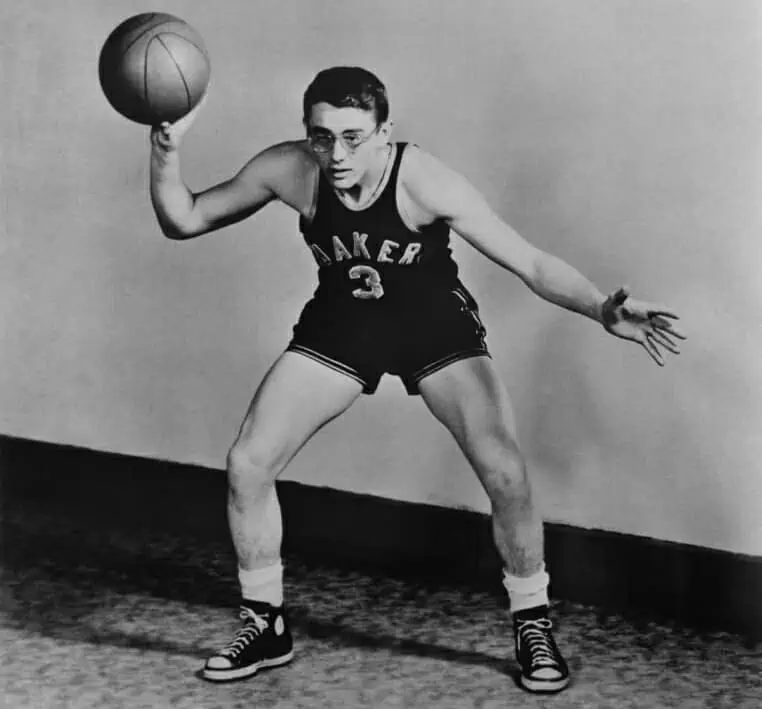
Film & Television Career – Game Shows, TV Dramas, and Hollywood Stardom
Dean’s first television appearance was in a Pepsi-Cola commercial, and his first speaking role was as John the Apostle, in an Easter television special dramatizing the Resurrection of Jesus. Dean subsequently obtained minor and uncredited walk-on roles in five films between 1951 and 1953. While struggling to get jobs in Hollywood, Dean also worked as a parking attendant at CBS Studios, during which time he met Rogers Brackett, a radio advertising executive, who offered him professional guidance.
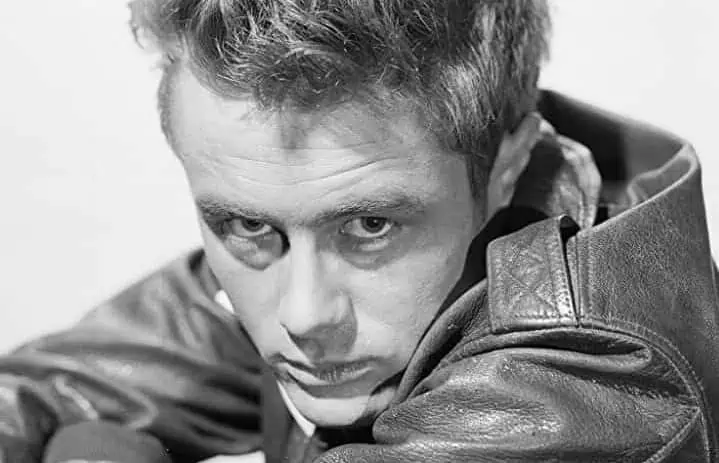
In October 1951, following the encouragement of Brackett, Dean moved to New York City, where he first worked as a stunt tester for the game show Beat the Clock. He also appeared in episodes of several CBS television series, such as Studio One and Lux Video Theatre, before gaining admission to the Actors Studio to study method acting under Lee Strasberg.
Proud of this accomplishment, Dean referred to the Actors Studio in a 1952 letter to his family as “the greatest school of the theater. It houses great people like Marlon Brando…Very few get into it…It is the best thing that can happen to an actor. I am one of the youngest to belong.” Dean’s career picked up, and he performed in further episodes of such television shows as Kraft Television Theatre. One early role, for the CBS series Omnibus, saw Dean portraying the type of disaffected youth for which he would later become famous.
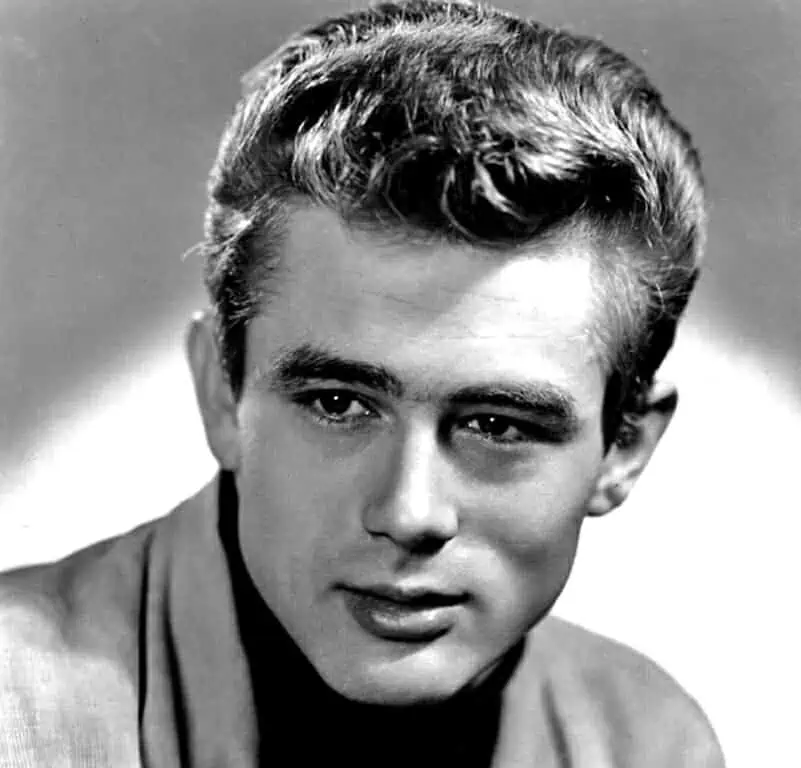
East of Eden – Dean’s Major Film Breakthrough
In 1953, director Elia Kazan was looking for an actor to play the role of Cal Trask, an emotionally complex young man who is bothered by the mystery of his supposedly dead mother, in the adaptation of John Steinbeck’s 1952 novel East of Eden. Kazan said that he wanted “a Brando” for the role, and the screenwriter suggested Dean. Steinbeck, who met with Dean, did not like him personally but thought him to be perfect for the part. Dean was cast in the role and on April 8, 1954, left New York City and headed for Los Angeles to begin shooting.
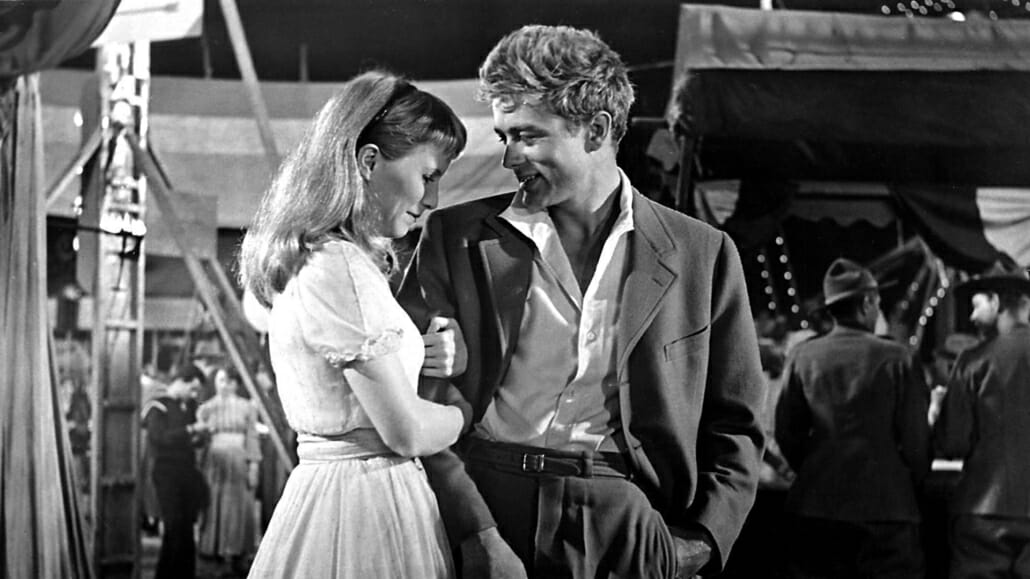
Much of Dean’s performance in the film is unscripted; his most famous improvisation occurs during a heated moment between Cal and his father. Instead of running away as the script called for, Dean instinctively turned to actor Raymond Massey, lunged forward, and grabbed him in a full embrace, crying. Kazan kept this and Massey’s shocked reaction in the film.
In recognition of his performance in East of Eden, Dean was nominated posthumously for the 1956 Academy Awards as Best Actor in a Leading Role, the first official posthumous acting nomination in Academy Awards history. East of Eden was the only film starring Dean that he would see released in his lifetime.
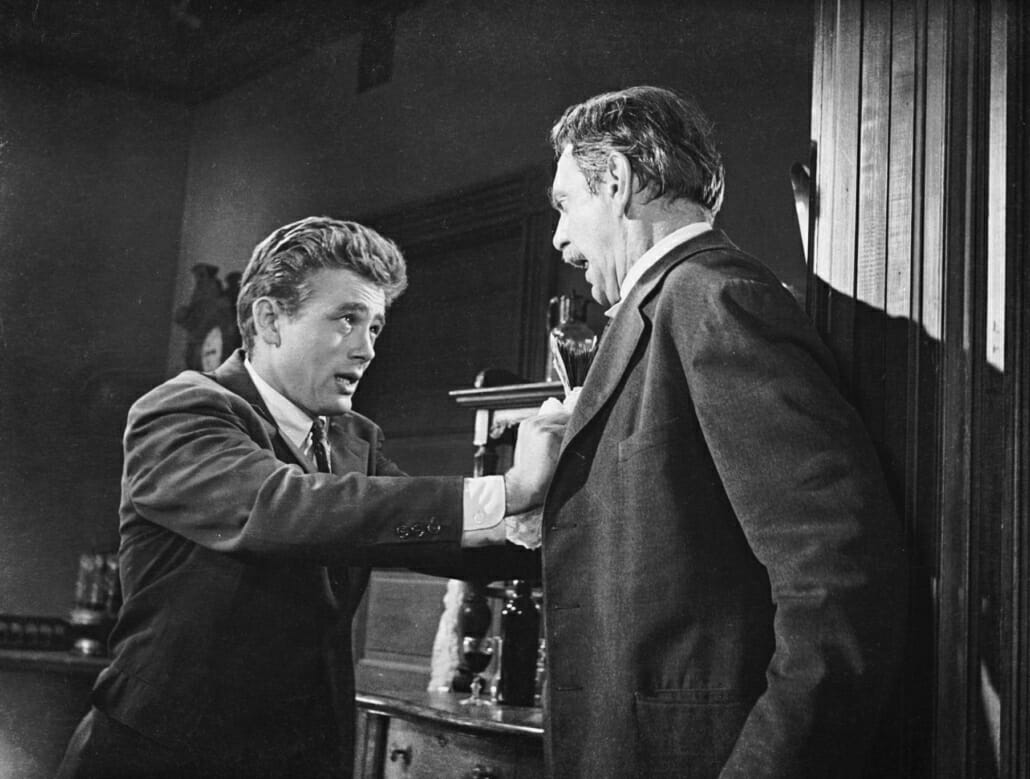
Rebel Without a Cause – The Quintessential Dean Performance
Dean’s next film, Rebel Without a Cause (1955), would become hugely popular among teenagers, largely for its representation of teenage angst. As Jim Stark, Dean gave the quintessential performance of a restless teenager, hiding behind a mask of casual indifference while yearning for love, purpose, and recognition. In the film’s opening scene, a drunk Jim slouches on a curb, holding onto a toy monkey. The conservative tan suit he wears marks him as an adult, but his movements are those of a frightened child.
Jim suffers emotionally because of his father’s weakness and is determined not to become like him. He seeks out one daredevil challenge after another, falls in love with Judy (Natalie Wood), and along with her and social outcast Plato (Sal Mineo), finds himself wrapped up in a night of gang violence and murder–his search for purpose in an uncaring world forcing him to navigate an environment of emotional darkness and ambiguity.
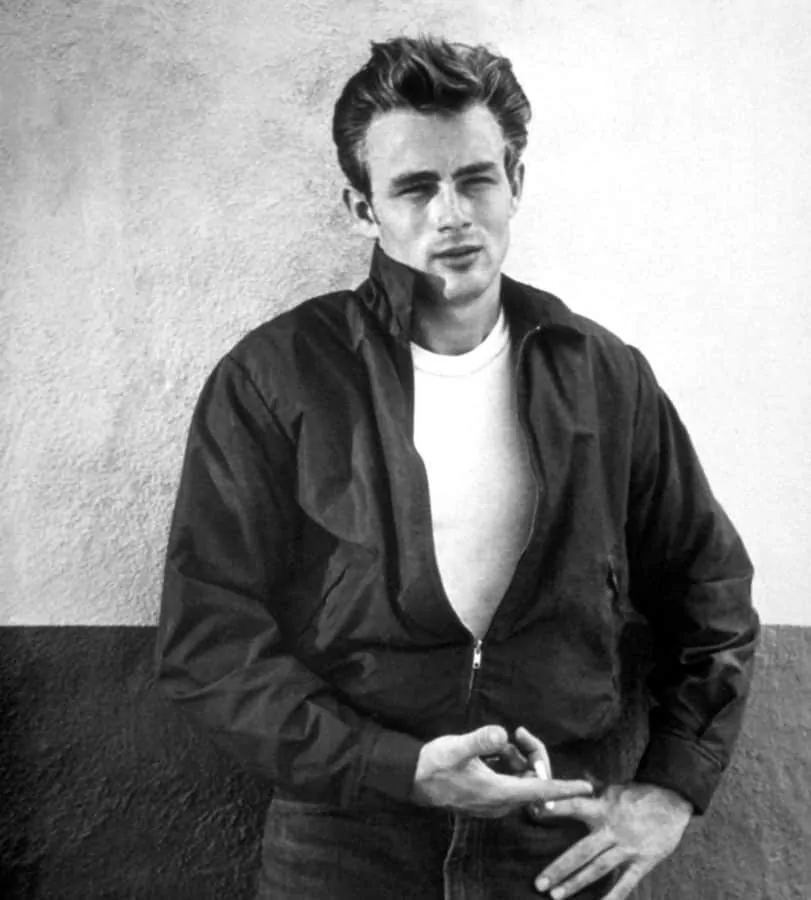
Giant – Dean’s Final Film
Following the successes of Eden and Rebel, Dean wanted to avoid being typecast as a rebellious teen, and hence took on the role of Jett Rink, a Texan ranch hand, in Giant (1956). The movie portrays a number of decades in the lives of Bick Benedict, a Texas rancher, played by Rock Hudson; his wife, Leslie, played by Elizabeth Taylor; and Rink. To portray an older version of his character in the film’s later scenes, Dean dyed his hair gray and shaved some of it off to give himself a receding hairline.
Dean received his second posthumous Best Actor Academy Award nomination for his role in Giant. At the time of his death, he was set to star as Rocky Graziano in Somebody Up There Likes Me (1956); that film went on to earn both commercial and critical success, winning two Oscars, with Paul Newman playing the role of Graziano.
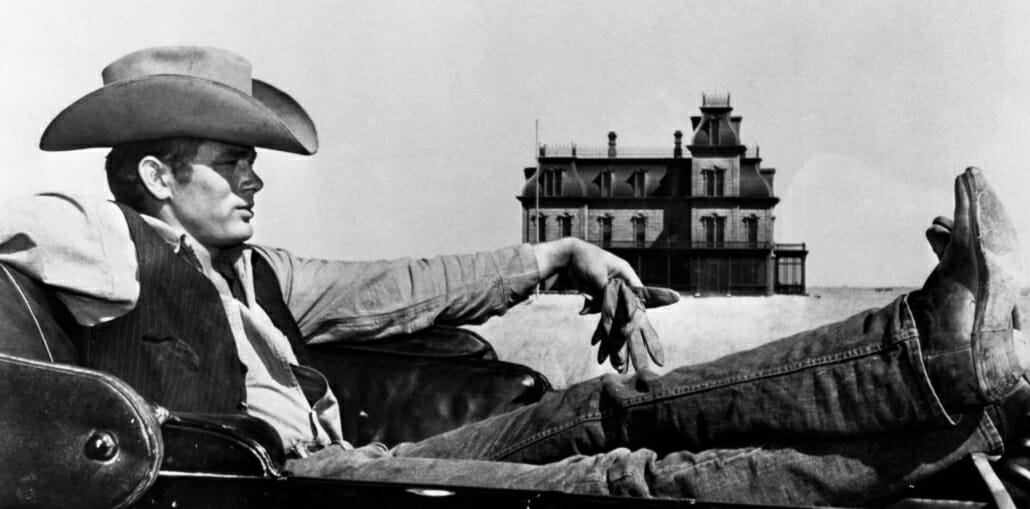
James Dean’s Death – A Racer Passes on the Highway
A fan of auto racing since his childhood, Dean became interested in developing a racing career. Beginning in 1954, he purchased various vehicles after filming for Eden had concluded, including a Triumph Tiger T110 motorcycle and a Porsche 356. Just before filming began on Rebel, he competed in his first professional event in Palm Springs, California, winning first place in the novice class and second place at the main event. His racing continued in Bakersfield a month later, where he finished first in his class and third overall.
Dean hoped to compete in the Indianapolis 500, but his busy schedule made it impossible. Dean’s final race occurred in Santa Barbara, California, in May 1955; he was unable to finish the competition due to a blown piston. Following this, the Warner Bros. studio barred him from all racing during the production of Giant. Dean had finished shooting his scenes, and the movie was in post-production when he decided to race again.
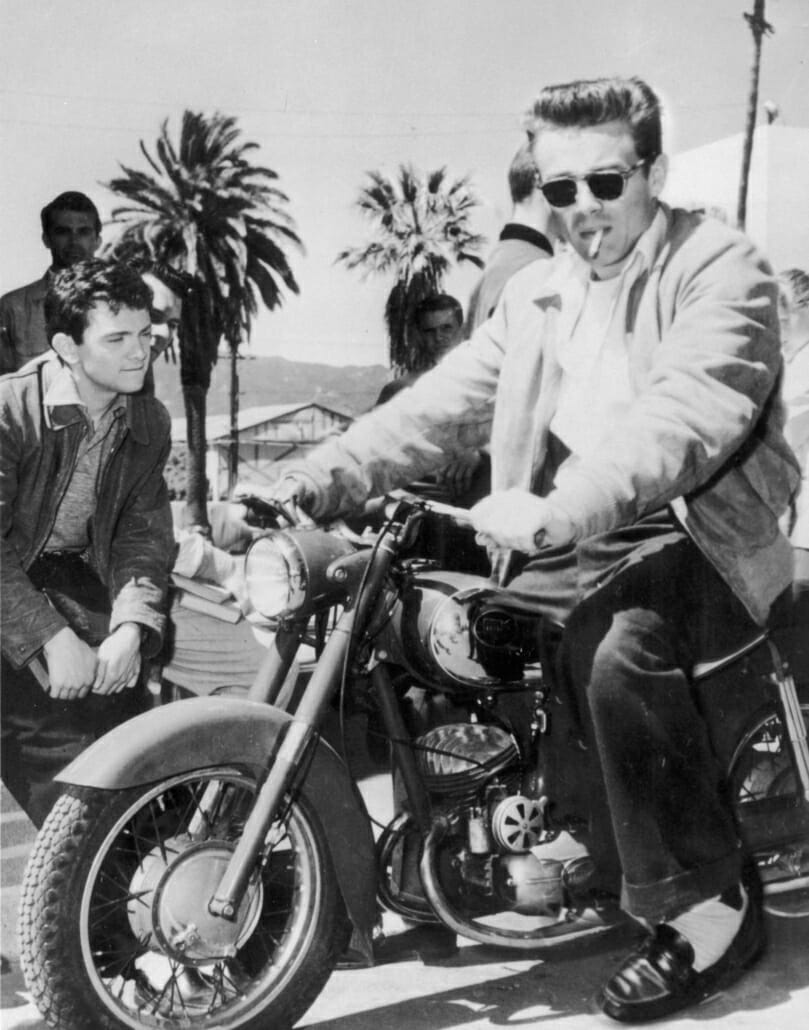
Dean was scheduled to compete at a racing event in Salinas, California on September 30, 1955. Accompanying the actor to the occasion was stunt coordinator Bill Hickman, Collier’s magazine photographer Sanford Roth, and Rolf Wütherich, the German mechanic from the Porsche factory who maintained Dean’s Porsche 550 Spyder, which Dean referred to as his “Little Bastard.” Wütherich, who had encouraged Dean to drive the car from Los Angeles to Salinas to break it in, accompanied Dean in the Porsche. At 3:30 p.m., Dean was ticketed for speeding, and the group continued to travel along U.S. Route 466.
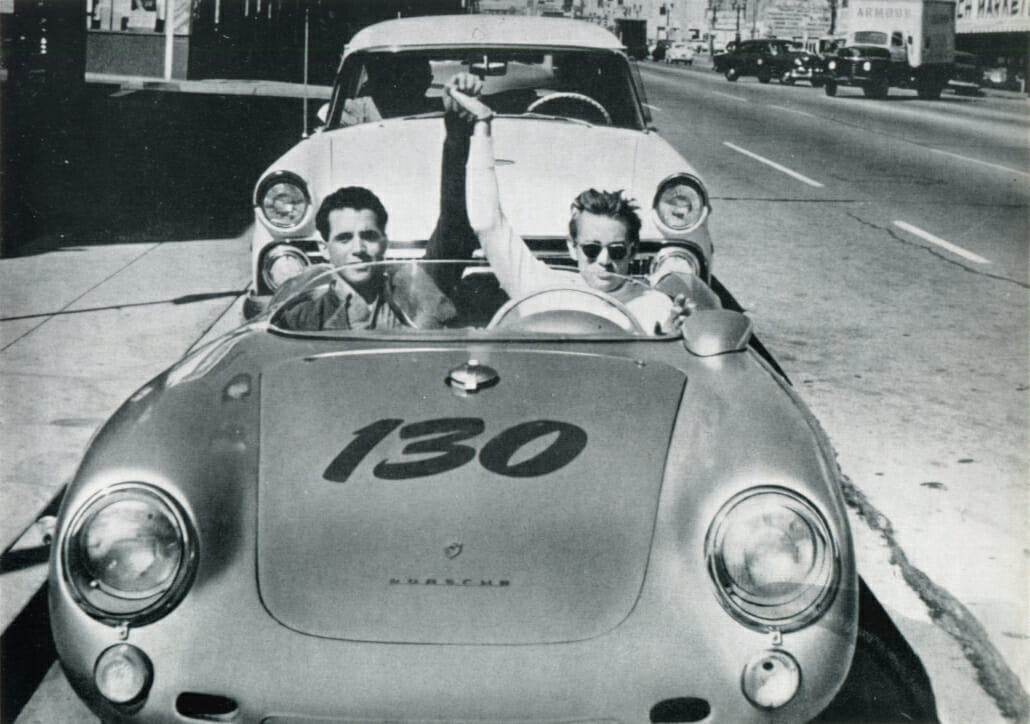
At approximately 5:45 p.m., a car was passing through an intersection while turning, ahead of the Porsche. Unable to stop in time, Dean’s Porsche slammed into the driver’s side of the turning car, bouncing across the pavement onto the side of the highway. Wütherich was thrown from the Porsche, while Dean was trapped inside, sustaining numerous fatal injuries including a broken neck; meanwhile, the other driver had only minor injuries.
The accident was witnessed by a number of passersby who stopped to help; despite this, Dean was pronounced dead on arrival shortly after he arrived by ambulance at the Paso Robles War Memorial Hospital at 6:20 p.m. An estimated 600 mourners attended his funeral, while another 2400 fans gathered outside of the building during the procession.
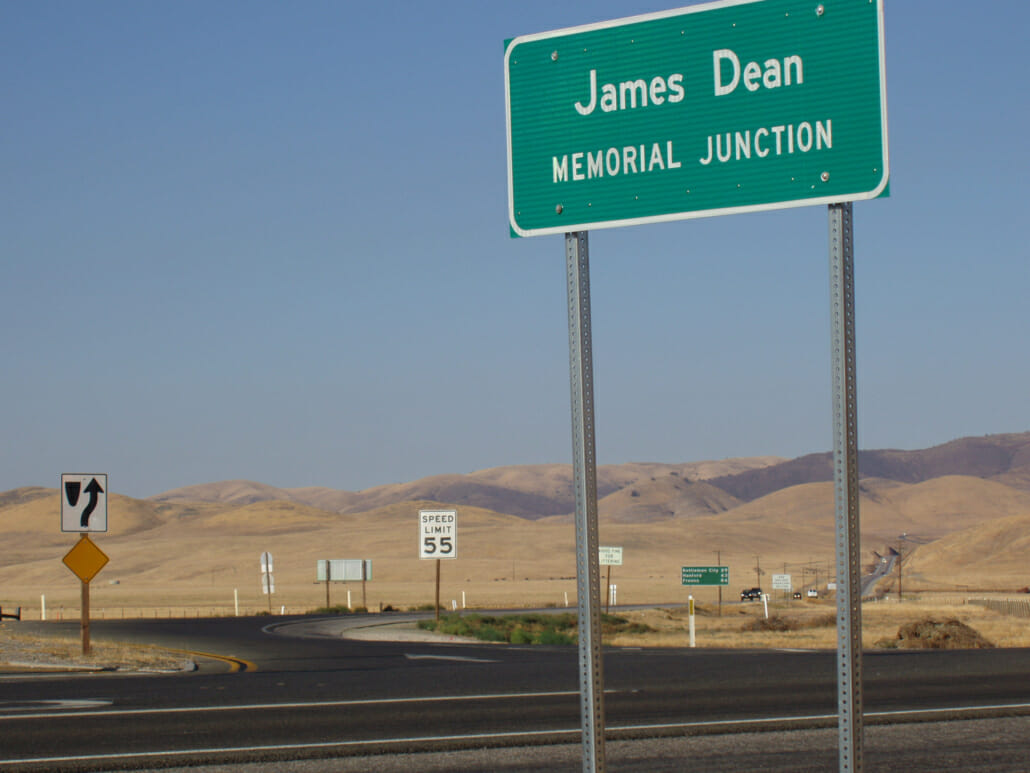
Legacy & Impact
American teenagers of the mid-1950s, when Dean’s major films were made, identified with Dean and the roles he played, especially that of Jim Stark in Rebel Without a Cause. The film depicts the dilemma of a typical teenager of the time, who feels that no one, not even his peers, can understand him. Humphrey Bogart commented after Dean’s death about his public image and legacy: “Dean died at just the right time. He left behind a legend. If he had lived, he’d never have been able to live up to his publicity.”
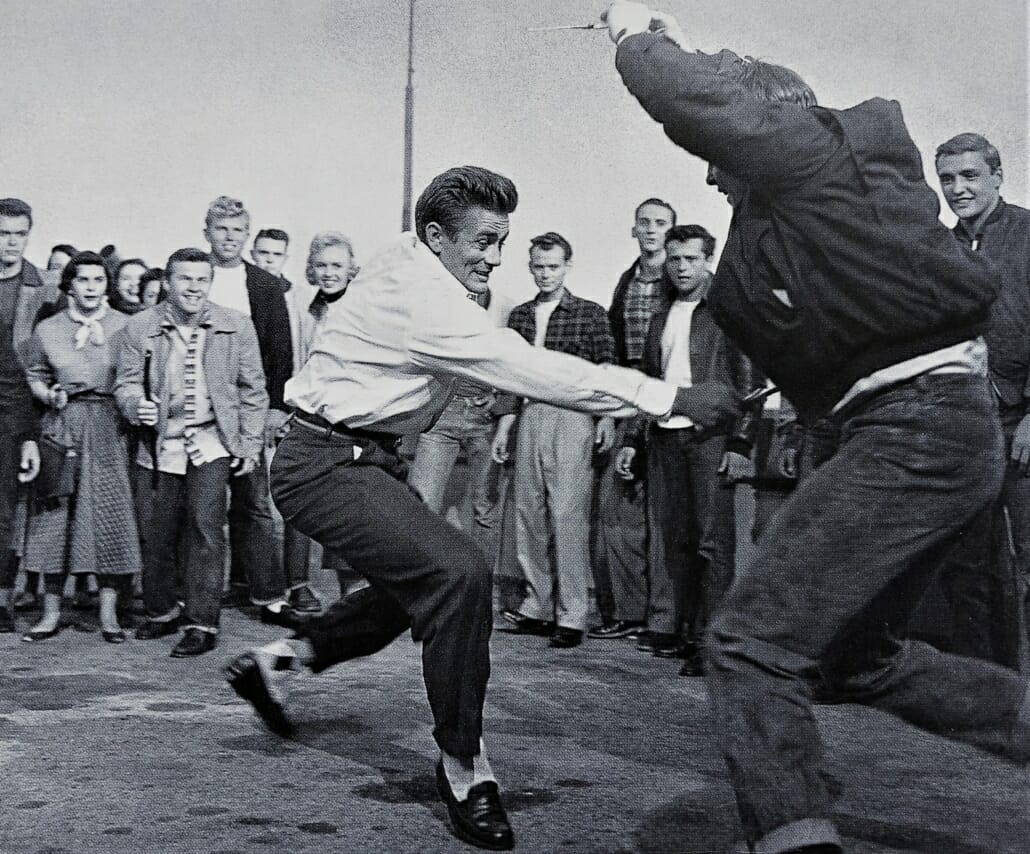
Additionally, numerous commentators have asserted that Dean had a marked influence on the development of rock and roll music. The persona Dean projected in his movies, especially Rebel, influenced many early rock pioneers, most notably Elvis Presley, who said in a 1956 interview for Parade magazine, “I’ve made a study of Marlon Brando…of poor Jimmy Dean…[and] of myself, and I know why girls…go for us. We’re sullen, we’re broodin’, we’re something of a menace…I don’t know anything about Hollywood, but I know you can’t be sexy if you smile. You can’t be a rebel if you grin.”
In their book, Live Fast, Die Young: The Wild Ride of Making Rebel Without a Cause, authors Lawrence Frascella and Al Weisel wrote, “Ironically, though Rebel had no rock music on its soundtrack, the film’s sensibility—and especially the defiant attitude and effortless cool of James Dean—would have a great impact on rock…The industry trade magazine Music Connection even went so far as to call Dean ‘the first rock star.'”
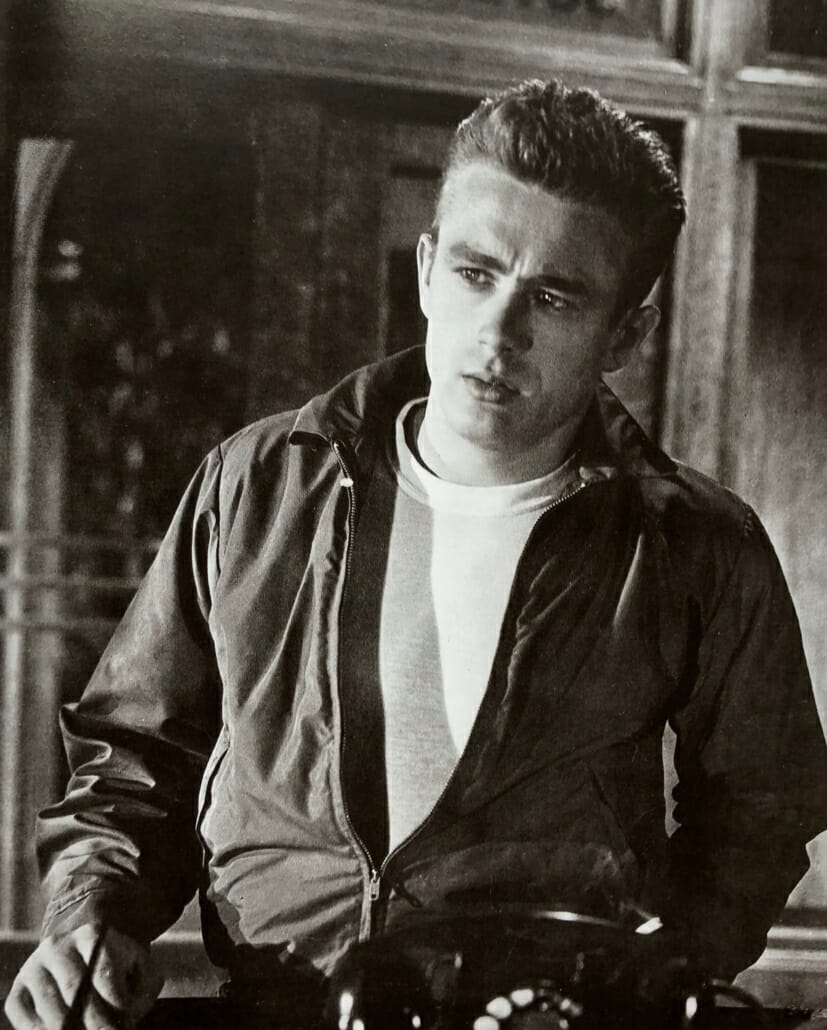
James Dean’s Signature Style
Dean was a studious and accomplished method actor, but perhaps more than his talent, it’s his natural charisma, as an avatar for rebellious youth, that shines through today. He didn’t abide by Hollywood standards of the time, preferring to live by his own rules. Many of the biggest male movie stars of the 1950s, such as Humphrey Bogart, Gary Cooper, or Cary Grant, were of the previous generation and represented “old Hollywood” with their side-parted hairstyles and tailored suits.
Meanwhile, Dean took a much more relaxed approach to dressing; he would show up to his early castings barefoot with safety pins holding together his torn trousers, and arrive at lunch dates shirtless and wearing old jeans. His disheveled appearance combined with his emotionally vulnerable screen performances did much to define a new era of masculinity, characterized by a rugged blend of machismo and sensitivity.
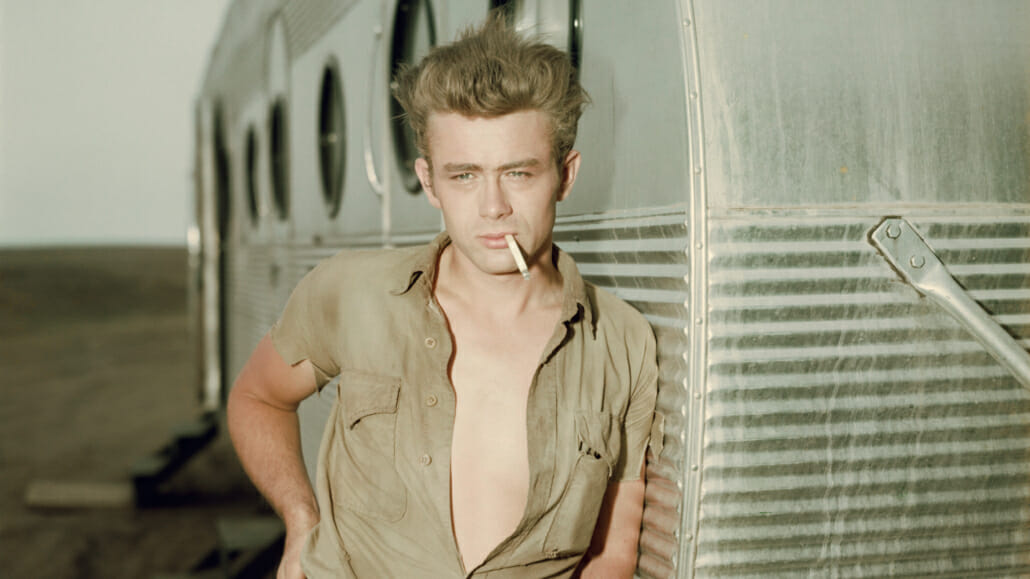
Dean’s personal style was inherently casual, and it’s likely that the years he spent on an Indiana farm influenced his largely function-first wardrobe. The bright red blouson in Rebel will forever be his signature look, but Dean wore a number of other lightweight jackets of greater versatility, including a tan suede jacket (in the same film), and a leather biker jacket with fur collar (clearly inspired by his hero, Marlon Brando) that helped to popularize the leather jacket as a wardrobe staple.
And where, prior to the ‘50s, the T-shirt was considered an undergarment, Brando changed that in A Streetcar Named Desire (1951), and Dean continued the trend in his own films. He likely favored T-shirts for their ease and simplicity, pairing them with denim, boots or penny loafers, and a cigarette. Today, an outfit consisting of jeans and a T-shirt is the norm for a great many men, but in Dean’s time, it was an act of defiance, taking considerable courage to wear.
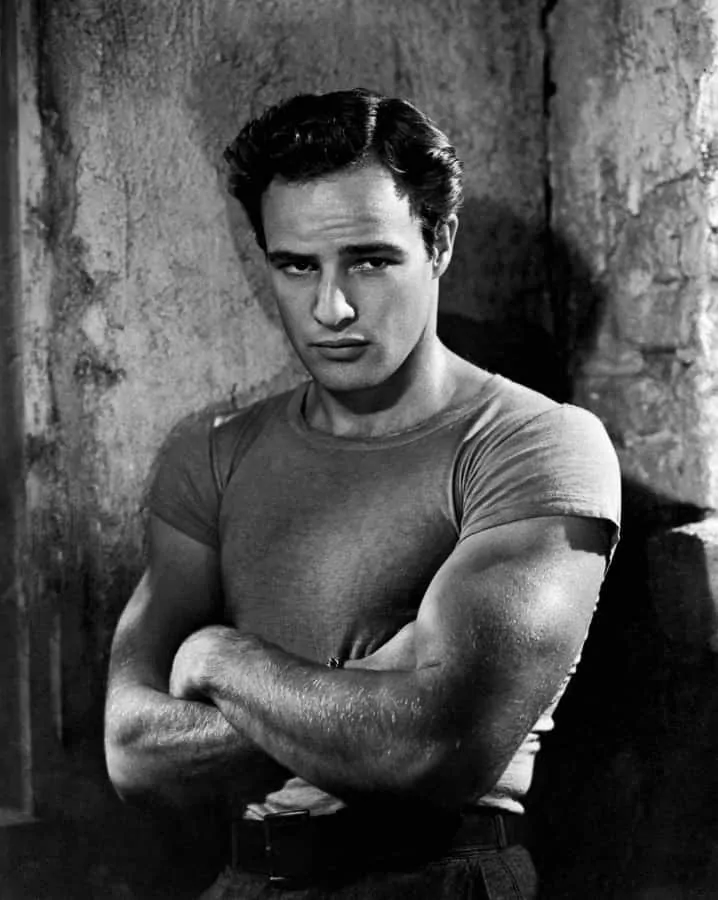
When dressing more conventionally, Dean’s fashion still remained true to his credo of simplicity and functionality. He could wear a standard suit (as in the opening scenes of Rebel), or go for a semi-formal ensemble: a sport coat or blazer in a color like brown or navy, a button-down shirt, khakis, and loafers. He was rebellious in his clothing choices but always projected a simple and masculine image. Simply stated, James Dean was an individual.
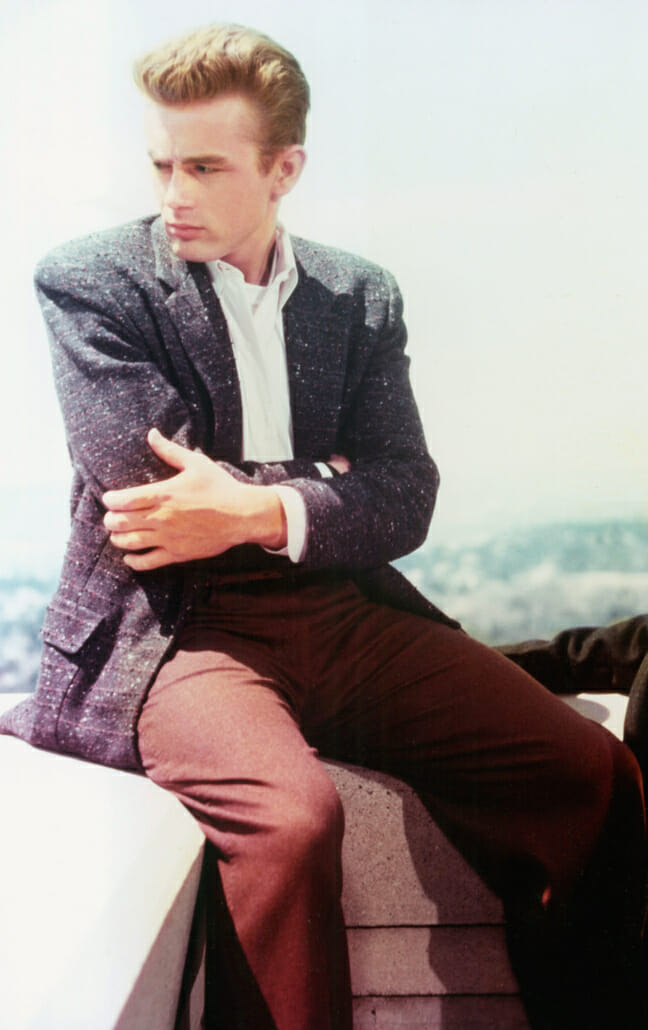
Harrington Windbreaker
As stated above, no singular piece of clothing is more indelibly linked to James Dean than the red Harrington windbreaker he wore in Rebel. The Harrington (named for its association with the character of Rodney Harrington on the 1960s TV series Peyton Place, and alternatively called a blouson) is a lightweight, waist-length piece of outerwear that layers quite well, especially in the cooler seasons.
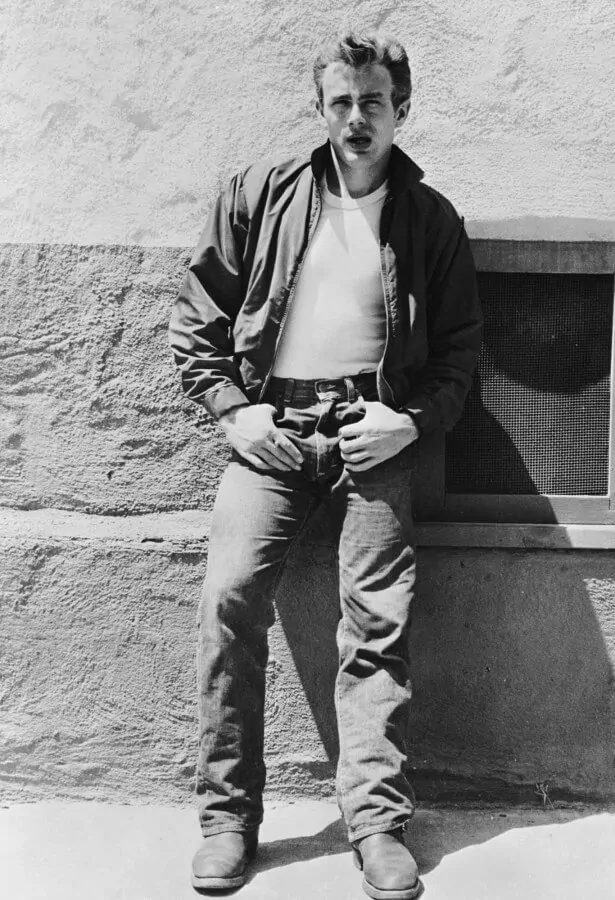
You can channel Dean directly by getting one in bright red, but other colors like beige, burgundy, or navy will be more versatile. Similarly, wearing it with a T-shirt, jeans, and boots will give you a distinctly ‘50s vibe, but the Harrington can be layered equally well with button-up shirts like flannels, odd trousers, and derby shoes or loafers. Alternatively, you can try a related piece of outerwear–such as a suede bomber jacket–paired with denim, for an even more rugged look.
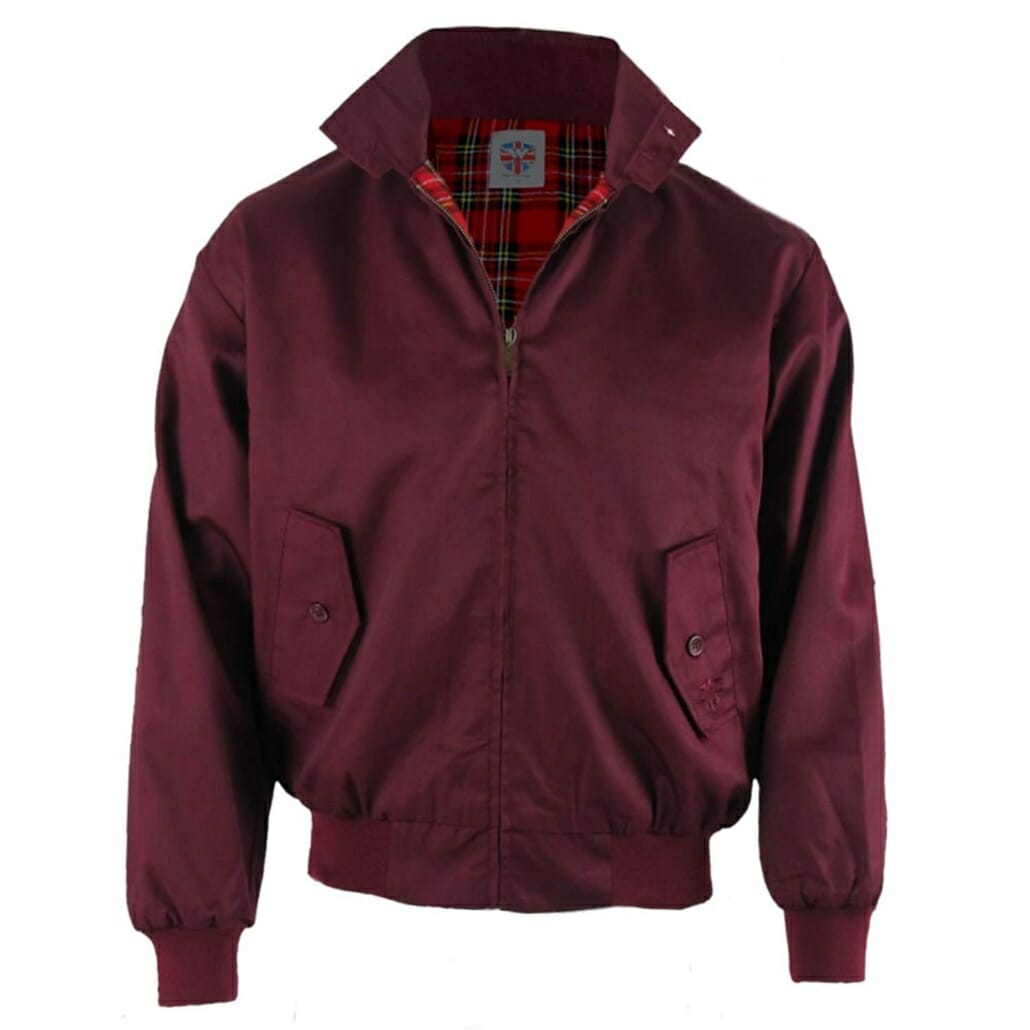
Jeans
As with the T-shirt, denim blue jeans have been a core piece of the modern American wardrobe since the 1950s, and Dean’s performance in Rebel did much to establish them as such. He wore a straight cut (not too loose or too tight throughout the leg) with a high rise, and in a medium blue wash; this classic style is still produced by many brands today, such as Levi’s and American Apparel. In particular, the Levi’s style known as the 501 was worn by Dean and is available today, and can be found in a large variety of different colors, including blue, indigo and dark washes.
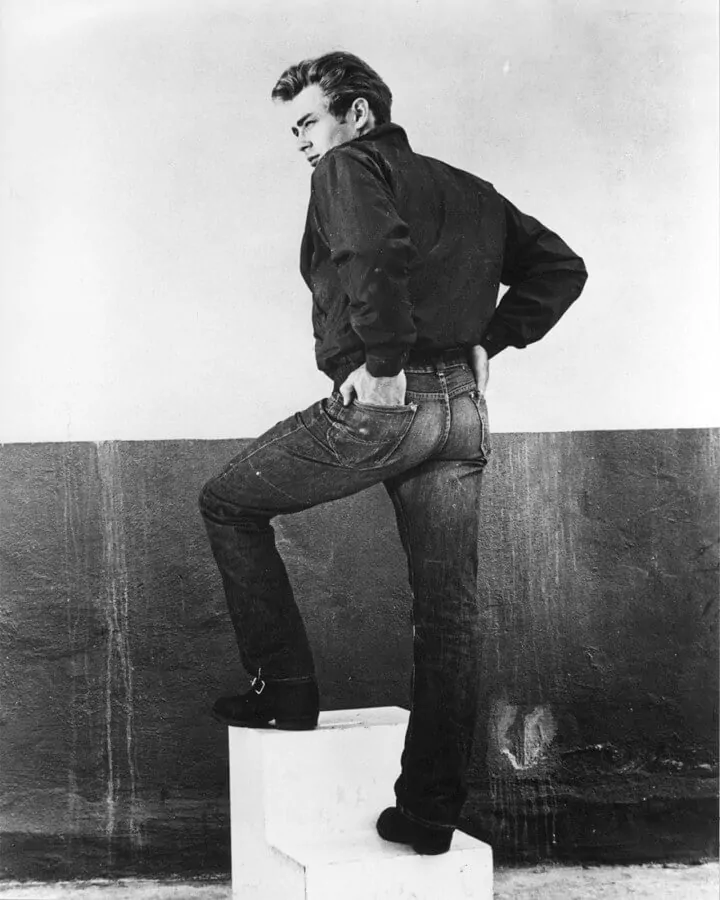
Given the time period in which he lived, Dean’s trousers had a fuller cut and a higher rise on the torso than what would be typical today. You can opt for a pair with a high rise to directly replicate a ’50s aesthetic, and combine it with classic loafers and a braided belt. For a more modern take, go for a pair with a contemporary rise, in a darker wash and tapered closer to the ankle.
In either case, your jeans should project an effortless, working-man masculinity. Layer your outfit with a leather jacket, and finish with some leather boots for an ensemble worthy of Dean (or Marlon Brando). Finally, cuff or pin-roll your jeans to show off your footwear and add an additional flair.
T-Shirt
Along with Marlon Brando, James Dean transformed the white T-shirt from a piece of utilitarian underwear to its current role as the backbone of hyper-casual attire. While we here at the Gentleman’s Gazette don’t often advocate for the T-shirt to be worn on its own as outerwear, its popularity as such can’t be denied, and if you’re going for the type of simplistic, rebellious, masculine look that Dean made famous, a T-shirt is an essential piece.
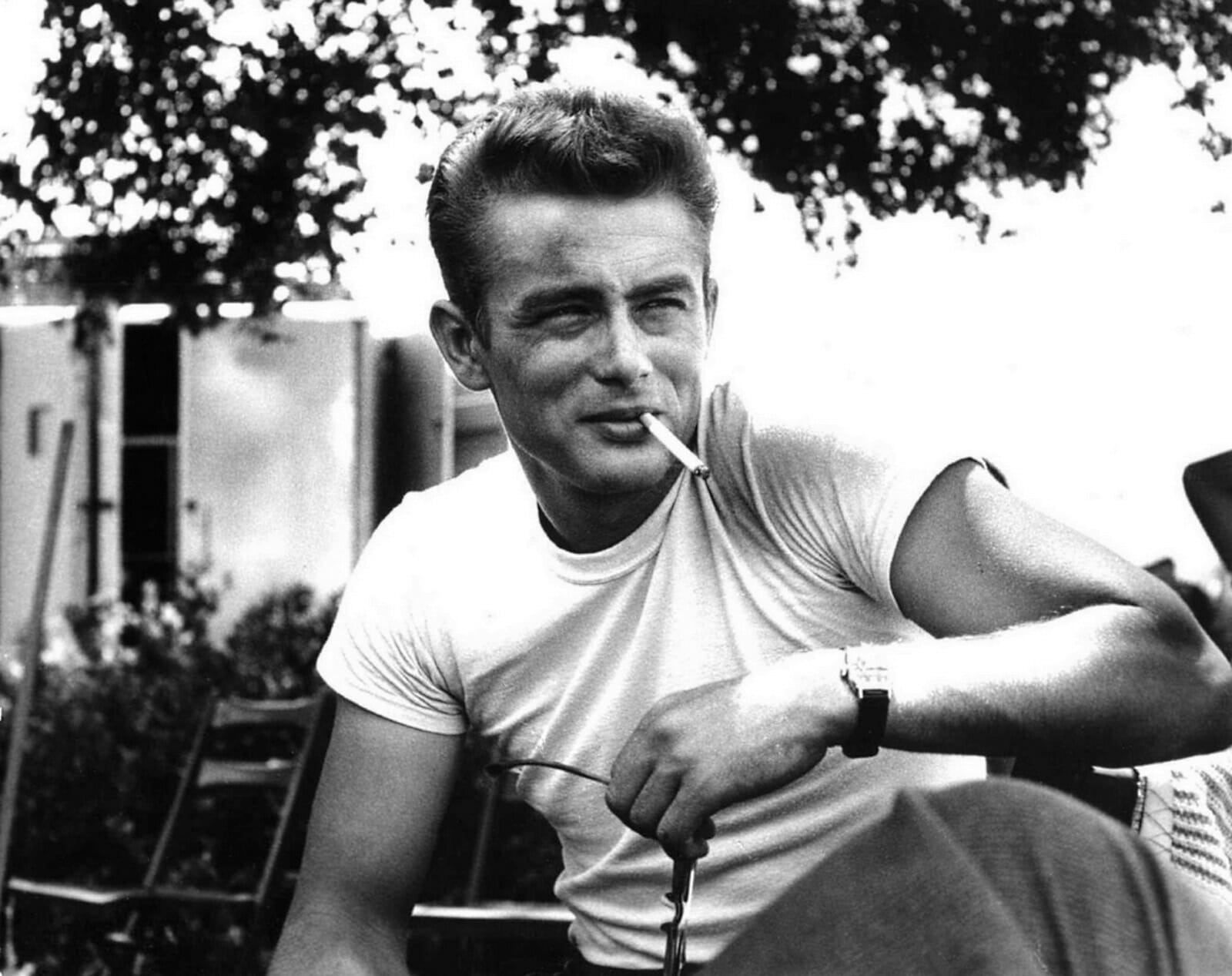
Still: as with any other type of garment, fit is key. Dean wore T-shirts that were well-fitted through the chest, with armholes that accentuated his arms without hugging them. If you do plan to wear a T-shirt visibly, don’t go for the same type of undershirt that you’d get in a multi-pack at Target or Wal-Mart; instead, spend a few more dollars to get something that will flatter your form and stand up to multiple launderings. To channel Dean directly, pair the tee with traditional blue jeans and boots. For a more contemporary look, dark denim with a slimmer (but not skinny) fit would be a good option.
Boots
In Rebel Without A Cause, Dean rounded out his iconic combination of Harrington, T-shirt, and jeans with a dark pair of leather engineer boots. Whether you’re deliberately attempting such a look or not, leather boots should be a staple of any man’s footwear collection, as they’re versatile in terms of formality and types of trousers, incredibly comfortable, and highly durable; a quality pair, maintained well, can last multiple decades.
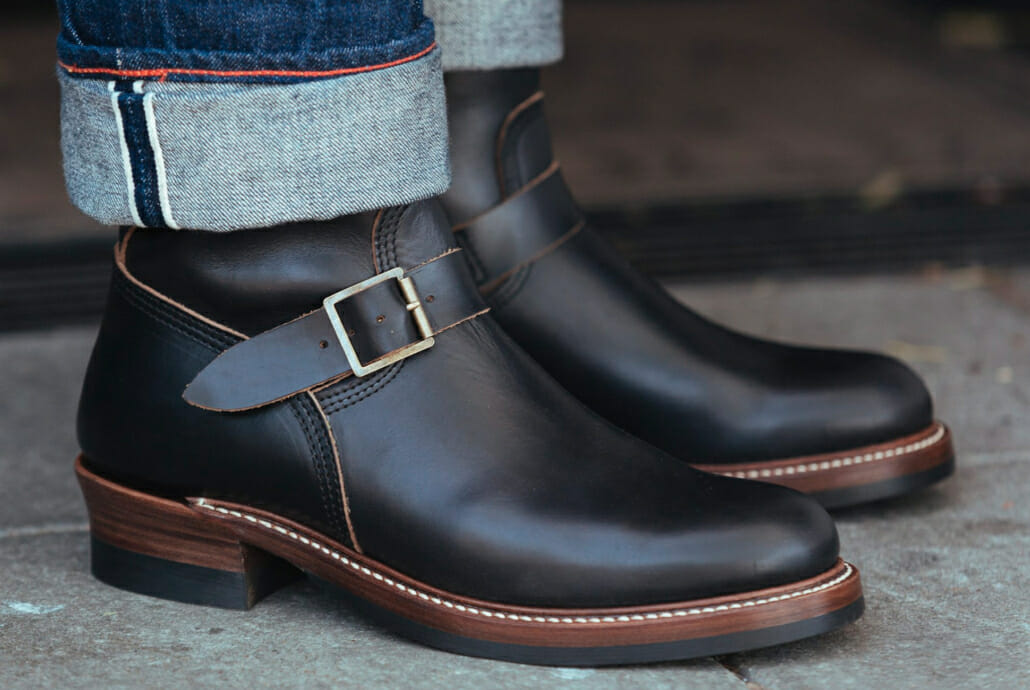
One of the most popular styles of leather boot today is the Chelsea boot, which pairs equally well with dress trousers, semi-formal pants, and denim. Picking up a pair of Chelsea boots (or other related styles) in both black and brown will provide your wardrobe with a surprising number of additional combinations.
Just remember: quality footwear is an investment, and boots are no exception. Snapping up any random pair you see on sale will only guarantee that you’ll have to buy another new pair in just a few months or years. Instead, buy from a reputable source that uses the highest quality materials, and you’ll save money in the long run, in addition to looking your best.
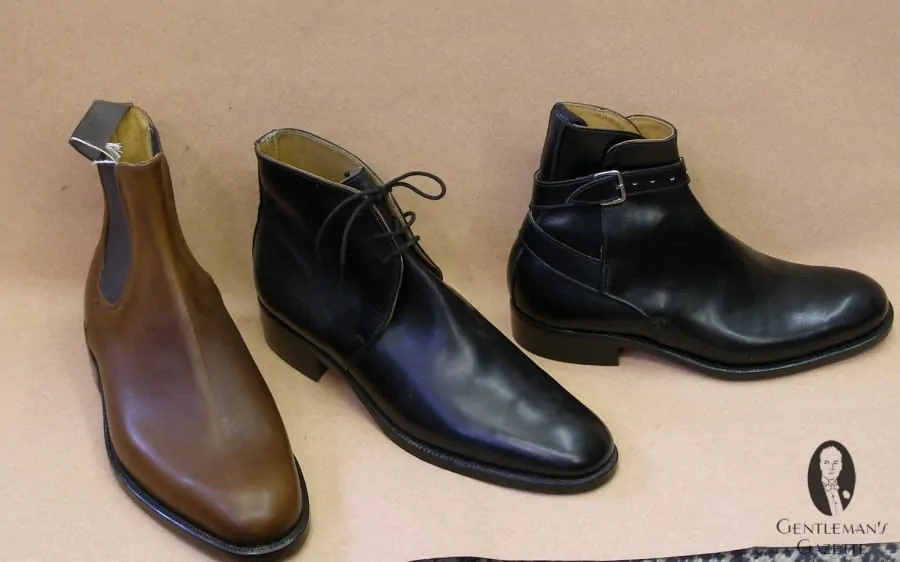
Polo Shirt
When not wearing a simple T-shirt, Dean could frequently be seen wearing its slightly dressier sibling, the polo, adopting the preppy look that defined his generation. Such a look is incredibly simple to achieve, and it’s entirely timeless. Dark, solid colors are the safest and most versatile options and can be worn tucked or untucked, depending on the formality level of your overall outfit.
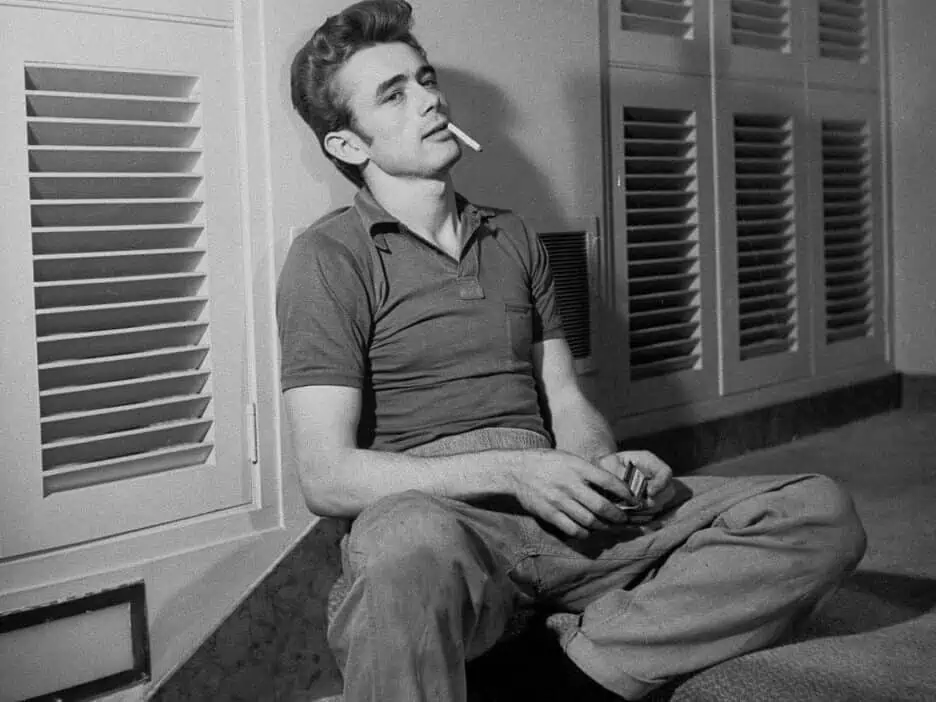
Polo shirts can pair easily with both cotton trousers (be they flannels, khakis, or chinos), as well as with denim; their versatility is what makes them a true style staple. Properly fitted polos made from lightweight weaves can be worn with dark-wash jeans and leather or suede shoes for a casual look. Alternatively, layer a polo under a sports coat or sweater, and pair it with odd trousers and loafers, for a more semi-formal ensemble that’s still relaxed.
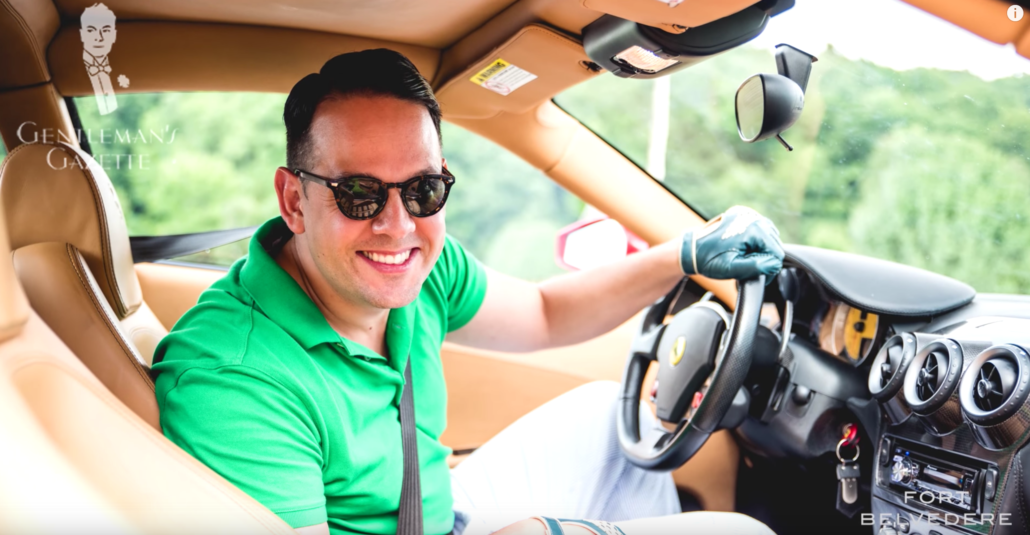
Sweaters
From his first starring role in East of Eden to his iconic 1954 photo shoot for LIFE magazine entitled “Torn Sweater,” Dean was also frequently seen in knitwear. In the case of the former, he wore a buff-colored V-neck over a white dress shirt, paired with khakis. For the latter, as the title would suggest, a worn and frayed black mock-turtleneck was the centerpiece of the outfit.
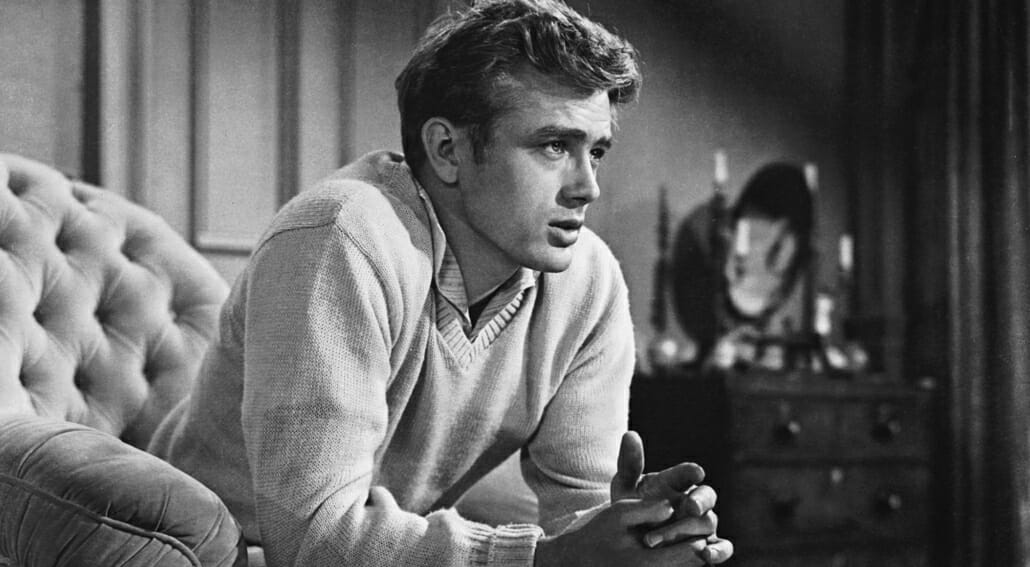
Each of these styles of sweater, while vastly different in attitude, is still versatile; as such, men looking to try Dean-inspired knitwear could opt for a neutral-toned sweater (either V-neck or crew-neck), paired with any color of khaki, chino, or even denim. Alternately, a black (or similarly dark) turtleneck could be paired with some black odd trousers or dark wash denim for a reserved, monochromatic look.
You’ll be safest with knitwear when avoiding more extravagant shades, and instead sticking to a color palette of grays, blacks, browns, blues, and greens. Such colors are fairly universal with odd trousers and boots, ensuring a variety of stylish combinations.
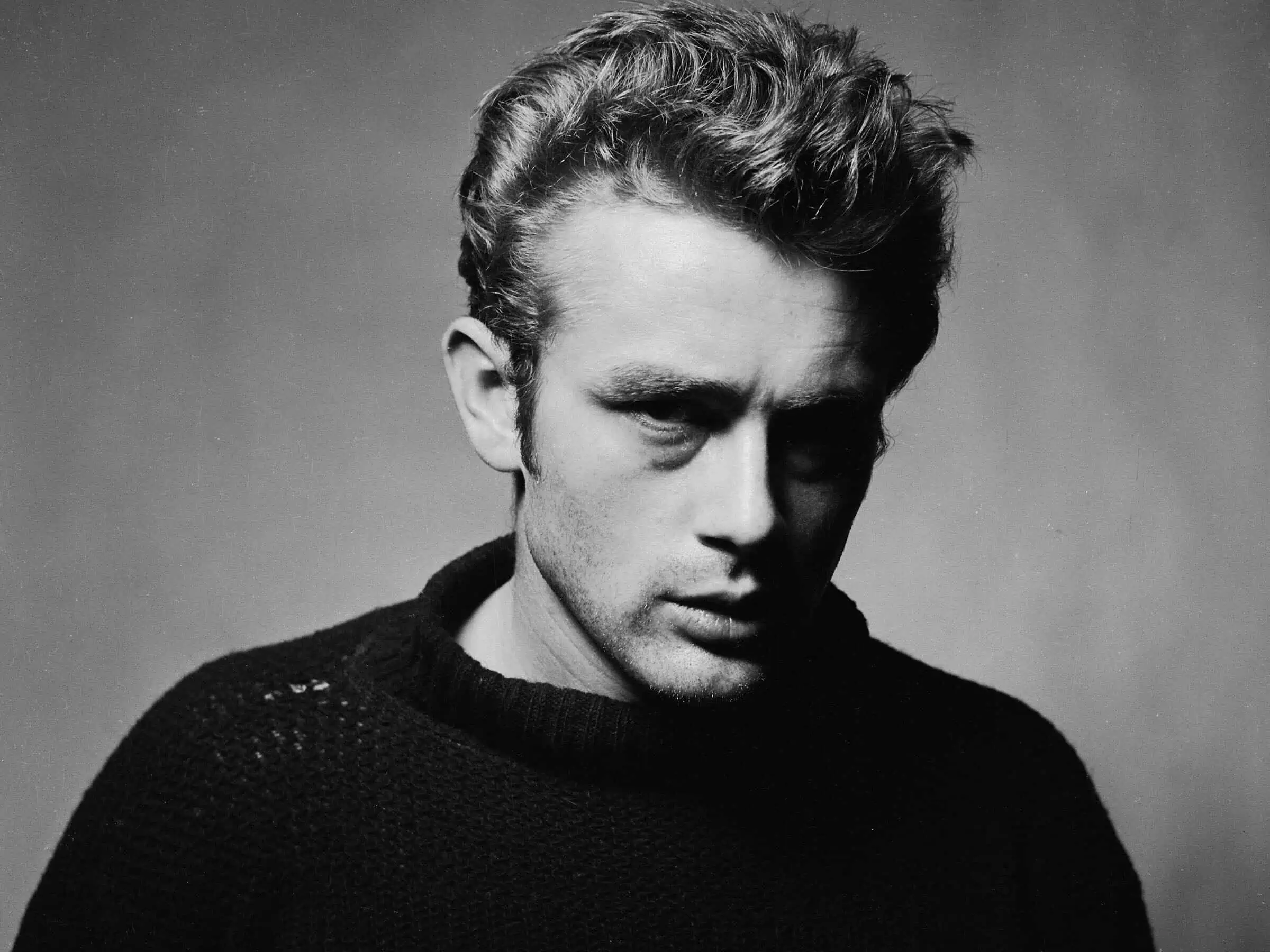
Breton shirt
Hailing from the Brittany region of France, the first iteration of Breton shirts were designed with tightly knit, locally sourced wool to protect fishermen from biting winds and water, and eventually evolved into a blue-and-white striped shirt. Sailors have sported the look since the start of the 19th century, and in 1858, the garments were officially adopted as part of the French naval uniform. Coco Chanel first brought Breton shirts into the realm of popular fashion, and from there, they were adopted by such icons as Audrey Hepburn, John Wayne, and of course, James Dean.
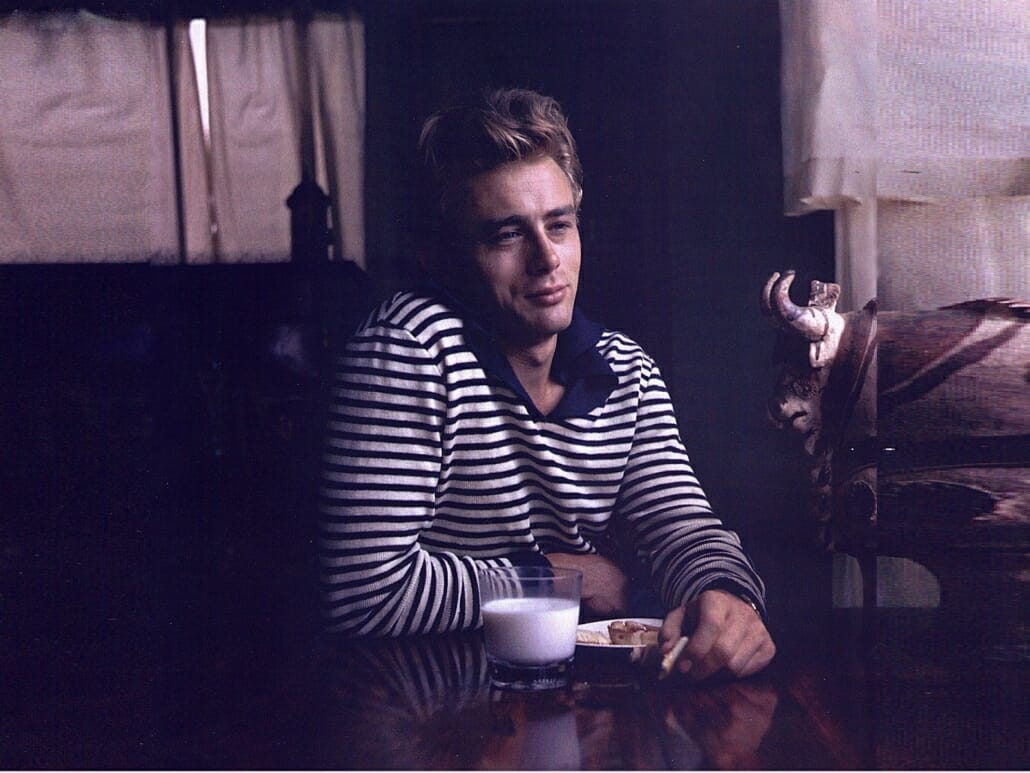
Stripes are considered by some men to be difficult to pull off, but this doesn’t have to be the case; for those just starting to integrate the pattern into their wardrobes, going for garments with narrow stripes and simple color combinations can be a great first step–and we can look to James Dean and his fondness for Breton shirts as an example.
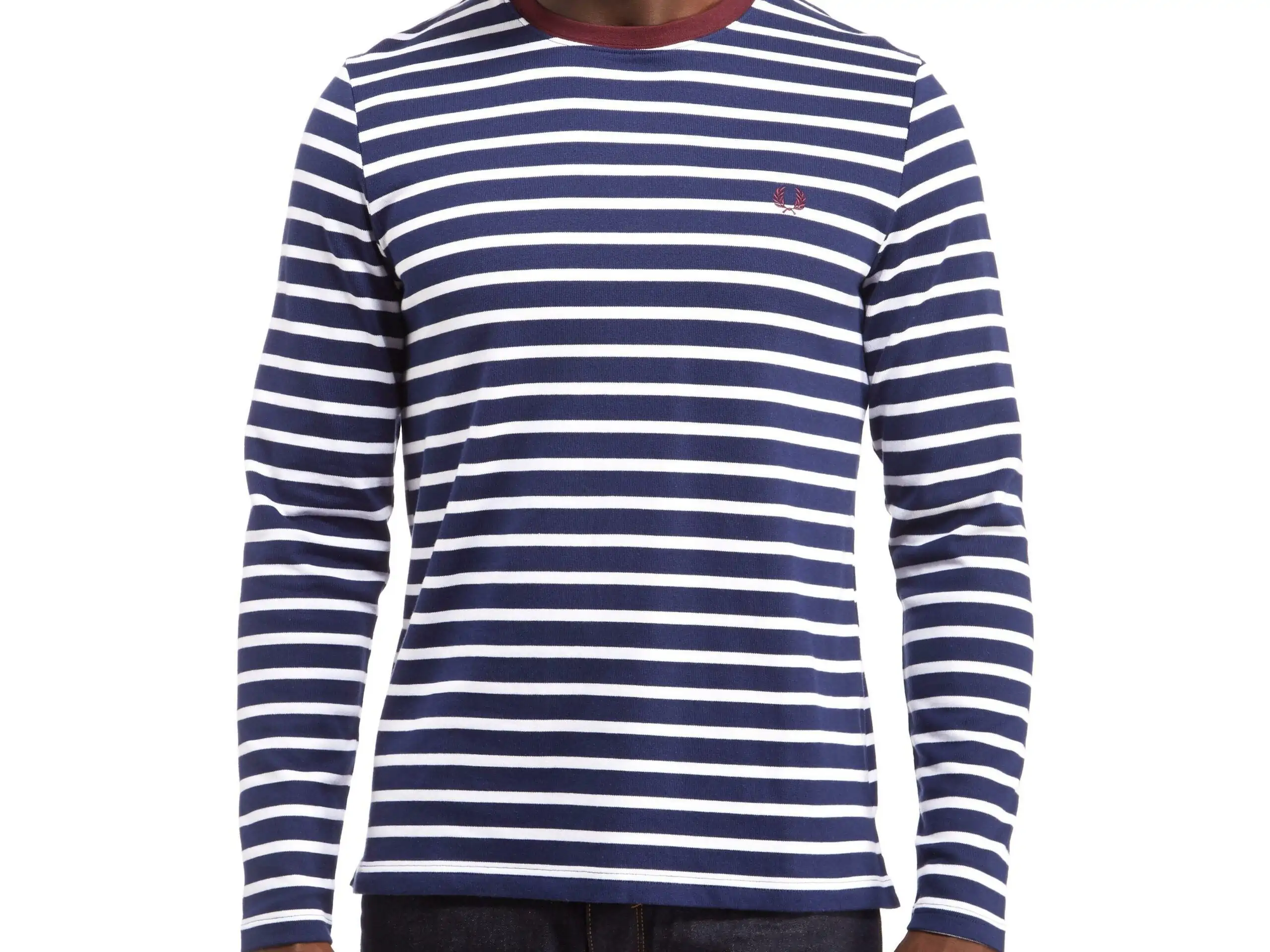
Sunglasses & Eyeglasses
Whenever you spend time in the sun (especially during the summer months), sunglasses are both functional and stylish, protecting your eyes and adding an unmistakable element of cool. Dean knew this, and he often sported a pair of round, tinted sunglasses with a thin metallic frame. While such styles remain popular and perfectly smart today, you can feel free to choose any type of sunglasses you like–so long as they fit your face shape and skin tone well.
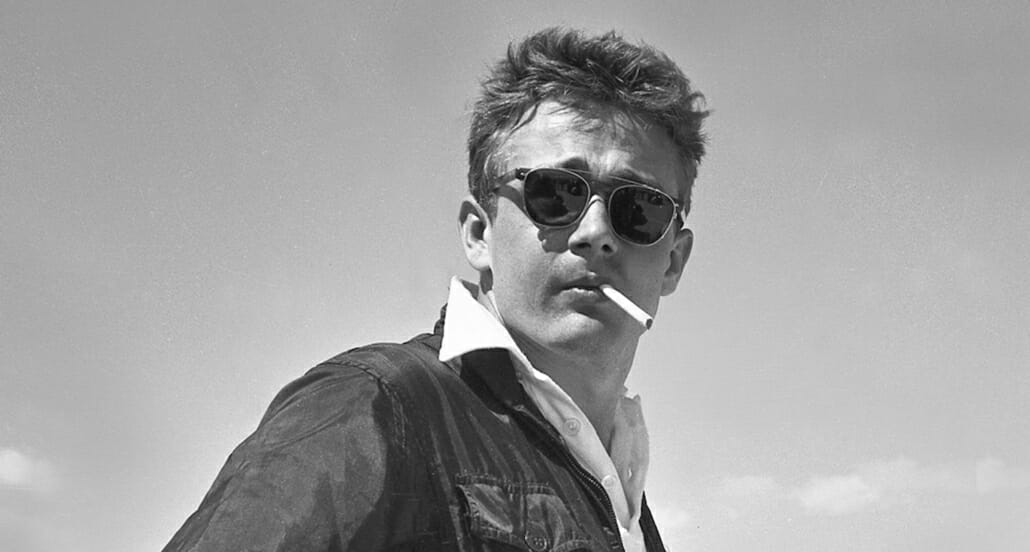
In addition to wearing sunglasses when outdoors, Dean also wore a pair of round, tortoise-shell eyeglasses, especially when reading. That he could pair a quite traditional style of eyeglasses with his otherwise casual look is a testament to his inherent sense of style. In either case, you can try pairing your eyewear with a casual shirt, like a T-shirt, polo, or Breton.
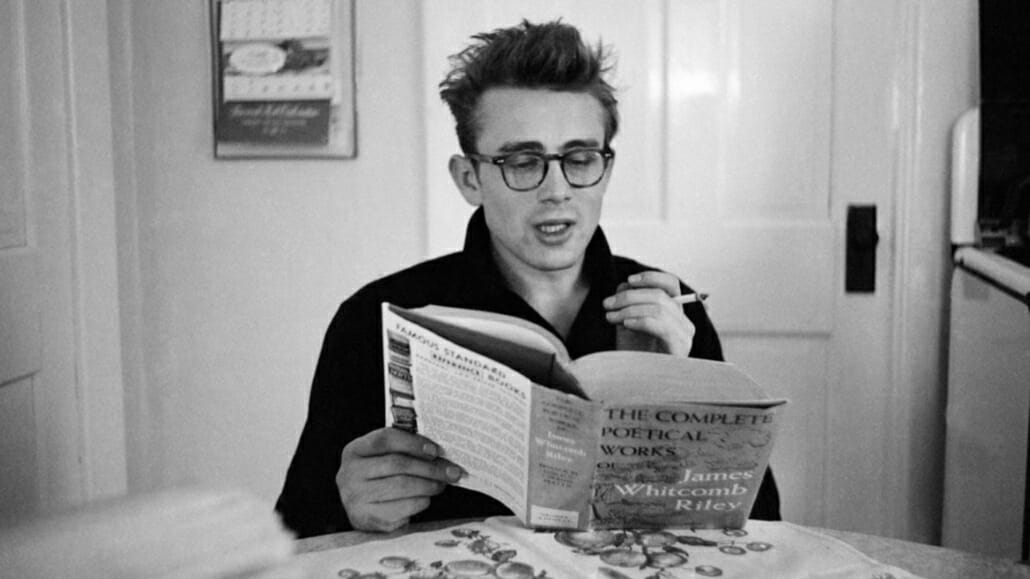
Especially when outdoors and wearing sunglasses in the summer, wearing a lighter fabric (such as linen) is a great way to stay cool and maintain a smart aesthetic. In this latter case, consider a pair of light blue jeans, as their brighter color will harmonize with the summery atmosphere of your look.
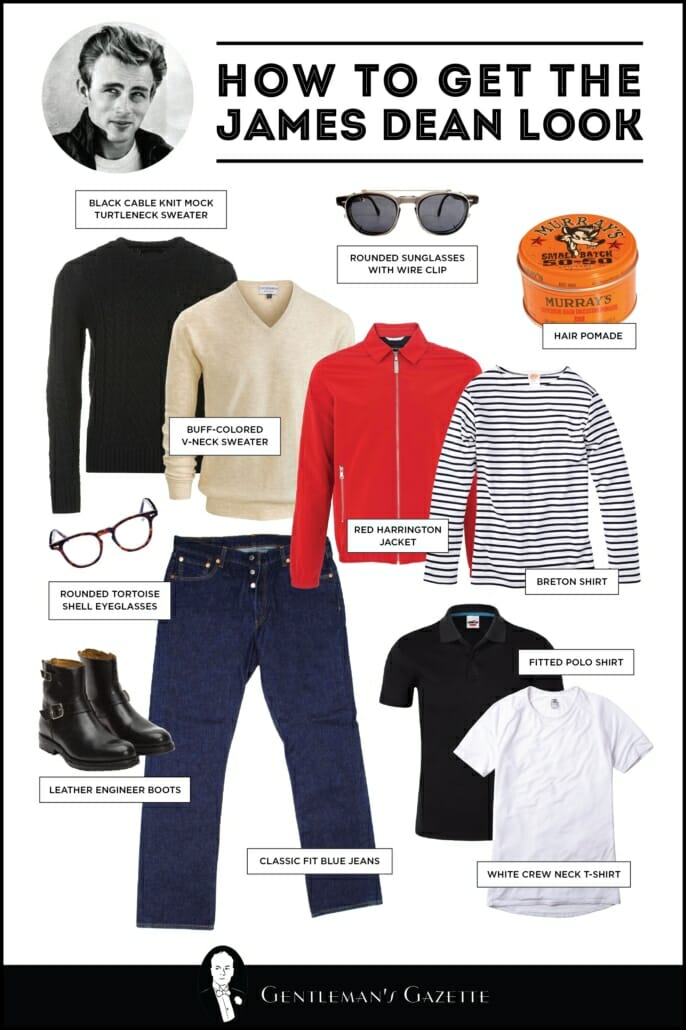
Hairstyle
Though perhaps not quite to the same degree as for his clothing, Dean was definitely famous for his hair. His disheveled, quiff-like pompadour projected a devil-may-care vibe, in line with the rest of his sartorial choices. Before Dean, the quiff wasn’t a popular style; it would have been considered too unprofessional for most men. Ever one to forge his own path, Dean made the style his own, and it’s since become a popular choice for many, particularly exploding in popularity in the last 10-15 years.
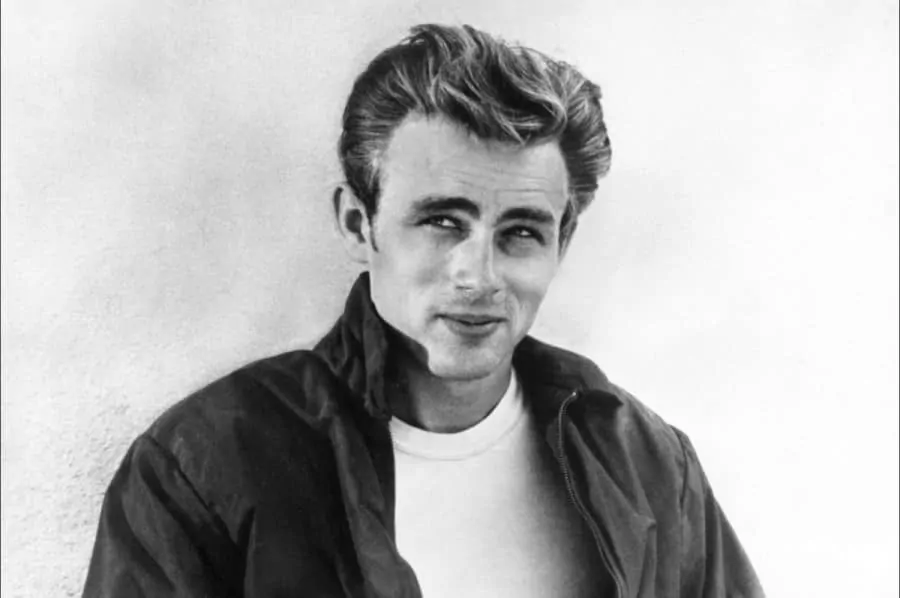
If you do decide to change up your hairstyle to be more like Dean’s, go to a skilled stylist who can cut your hair to the right length, with the bangs somewhere between your eyebrow and the bottom of your eye, and the back and sides scissor-cut and relatively long, to create a rounded look from the front.
After a cut and a shower, simply take a small amount of pomade and work it into your hands to get the pomade warm. Work the pomade into your hair evenly, making sure all of the hair has some product in it. Then, take a hair dryer and a comb or brush, and on a low heat, blow dry your hair and style it as desired. A bit of hairspray for hold, and the James Dean look is yours.
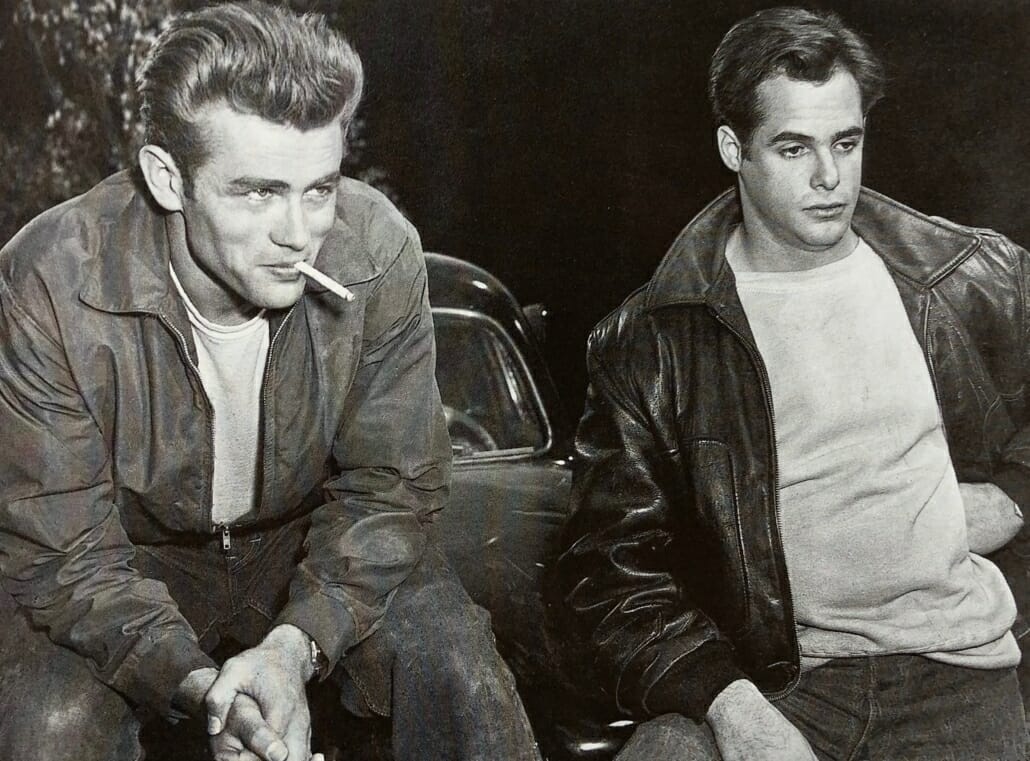
Conclusion
While the word “icon” has become especially overused in recent decades, it’s undeniable that the term suits James Dean–whether it’s because of his genuine talent as an actor, or the fact that his death at 24 left him frozen in time in the minds of the movie-going public. The combination of his rebellious characters and his casual style was a perfect storm for inspiration.
His style has a largely timeless quality, featuring simple pieces rooted in their functionality and versatility. Watch any of his films or peruse a few photos, and his confidence and cool shine through. Do you have a favorite James Dean performance or wardrobe item? Share with us in the comments.
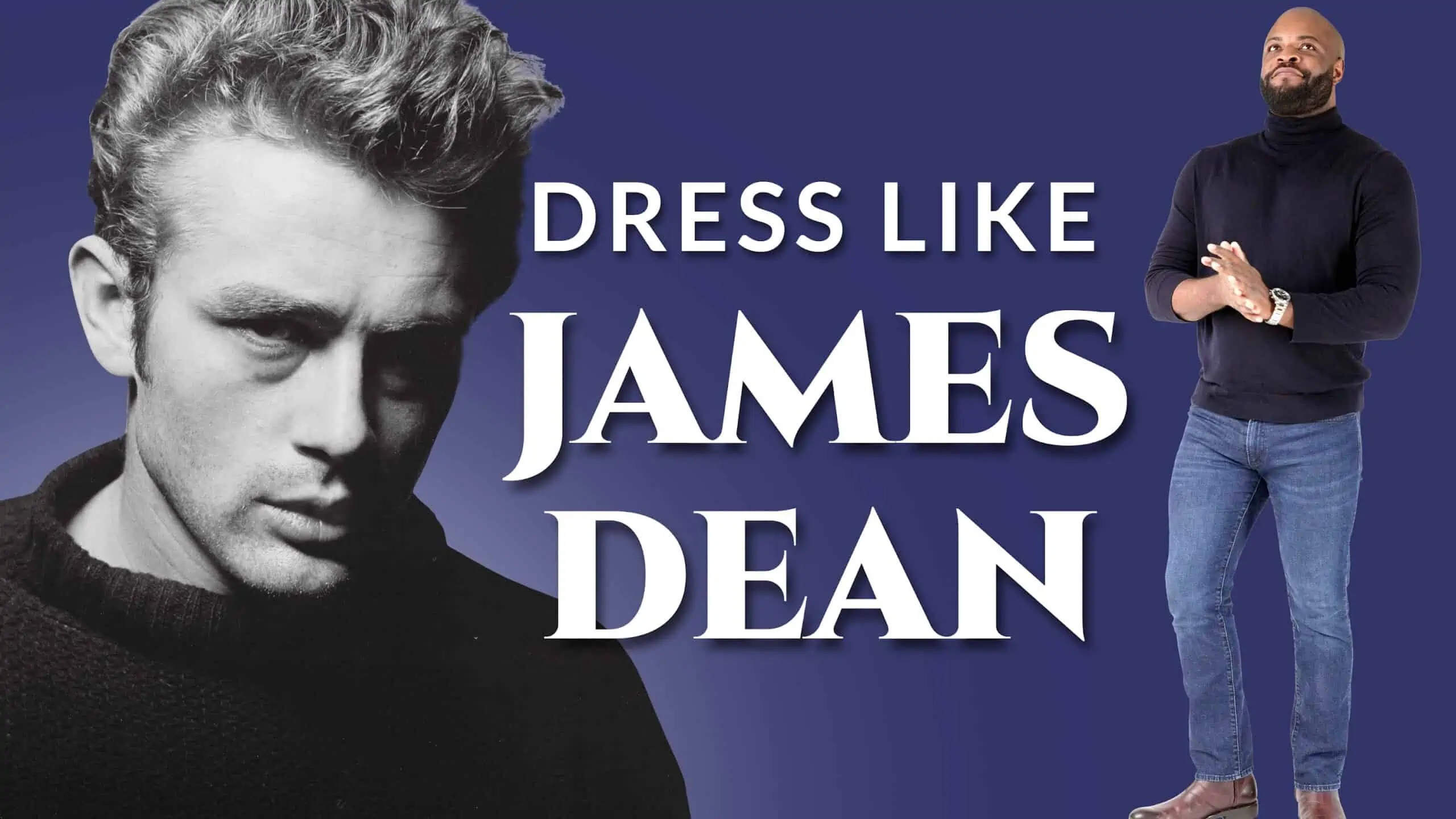
Please add that most of the “rebel” or “non-conformist” characters he played in his films were just that: characters. James Dean was a gentleman in all ways. Modern accident reconstruction technology indicates he was driving moderately, and that the other driver, blinded by glare, illegally drove into the intersection without properly yielding, too late for James Dean to avoid the accident, and that from measuring the skids and all other data, James Dean was driving a moderate speed considered safe for the driving conditions at the moment. So the other driver caused the accident and took away from us a great gentleman and actor.
Joan Collins had a ride in Jimmy’s Porsche:
“I was in a car one night and we were in a restaurant down town and we were going to go to see (pianist and actor) Oscar Levant, and I was going out with this guy called Arthur, and James said ‘come in my new car, I’ve got this new car’.
“It was a red Porsche. And he said, ‘I’ll race you, and we’ll go to Oscar’s which is in Beverly Hills’.
“So I got in the car with Jimmy and I’ve never been so frightened. He went so fast, and through red lights. Through Hollywood, got to Beverly Hills in less than five minutes and I got out and I said rather prophetically to (Paul) Newman ‘God, he could kill himself in that car’.
“And less than a month later he did.”
Another overpraised actor who remains famous today because his estate was wise enough to promote his image for post mortem profits, just like Monroe, Presley, etc. Talented? Sure. Iconic? An idol made of Pure PR. A key element in the creation of these icons is an early death, which does not require talent, merely termination.
You forgot to mention his Scott leather jacket.
Nice article on James Dean. You mention Brando several times… but did not mention the full relationship the two actors had together. Both men and their individual style evolved from their personal relationship. It is well documented how Dean’s bad boy style developed.
I think Humphrey Bogart was absolutely right: “If he had lived, he’d never have been able to live up to his publicity.” Dean is an icon not only because he died young and handsome amidst teenager hysteria – but above all because his imagery has been smartly marketed ever since: he remains forever young and cool, with that alluring whiff of tragedy about him. Had he lived to a ripe old age he might, with a lot of luck, be mentioned alongside someone like Dennis Hopper. More likely though, he would be in line with almost forgotten teen idols of the 1950ies like Scott Marlowe, Tab Hunter or Richard Bakalyan – and all of these, Bakalyan in particular, were better actors. But I very much doubt James Dean would ever have reached the status of a character actor, like Marlon Brando, Orson Welles or Paul Newman.
As for his attire and style: I would never have linked James Dean to the gentleman ideal. He may be called “cool” – but he lacks that quintessential feature of a gentleman: elegance. There are classy and far more elegant actors that come to mind: epitomes of style like David Niven, Cary Grant, Douglas Fairbanks jr. or Stewart Granger. Or on a more conservative note: Ray Milland, James Mason, Laurence Olivier, John Mills and John Gielgud. Or, in case you’re not familiar with their names, google images (because you’ll recognise their faces) of British picturebook gentlemen of the screen like Wilfrid Hyde-White and John Williams (John Williams the actor – not the composer).
PS: Don’t get me wrong, Mr. Schlueter: I found your article intriguing and a good read. It’s just that I would not put James Dean in the “gentleman” slot.
You are mixing up style with “a look”. James Dean had a look—a great look which personified the 1950’s—but it was not style. Cary Grant had style. Very different.
Sven, I am a 8th grade student and am trying to dress up more, I currently dress in polos and chinos everyday, how can I faze into OCBDs and the occasional casual jacket (tweed, seersucker, linen” without seeming pretentious?
Cheers from D.C, Henry
Sir,
Whatever James was stylist or non-gentleman but his charismatic appearance appealed to the youth of the 1950’s and created a storm with his iconic dressing sense and style. Worldwide the film actors of that era followed his fashion choice and that is the impact he embossed.
Rajesh Ghoghari
Thank you for posting this today on James Dean Birthday
A fine remembrance
Thank you for mixing fashion with stardom. Do not care what Dean was or was not; I liked what I saw, and that is enough. Bogart- what a ridiculous comment he made; a prophecy that never happened. Afterthought: Dean’s Dad was a jerk. Also, great ideas to get the “Deanlook.”